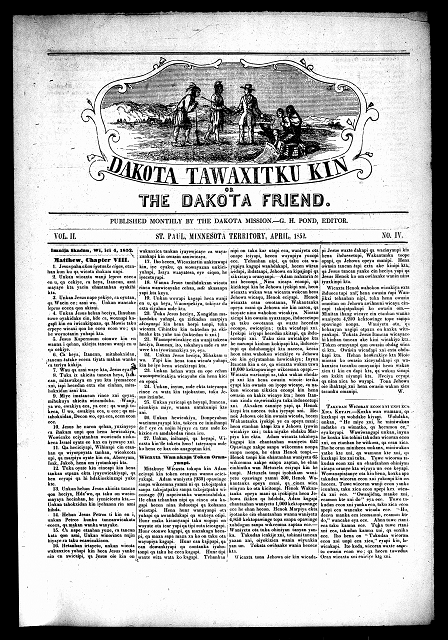Dakota Tawaxitku Kin, or, The Dakota Friend
Dakota Tawaxitku Kin, or, The Dakota Friend (Saint Paul, Minn.) 1850-1852 Browse the title
Dakota Tawaxitku Kin, or, The Dakota Friend was a Dakota- and English-language newspaper published in 1850-52 in St. Paul, Minnesota Territory, by the Dakota Mission and Editor G. H. (Gideon Hollister) Pond, a white missionary. Initially the newspaper was printed at the office of the Minnesota Chronicle and Register in St. Paul and later by the Minnesota Democrat. The four-page, three-column issues appeared monthly starting in November 1850 until the paper was suspended in October 1851 at the end of its first year. Publication resumed with several changes including a larger size and four-column pages in January 1852. The final issue of Dakota Tawaxitku Kin, or, The Dakota Friend appeared in August 1852.
The Isantee (Santee) or Eastern Dakota had resided in the land they called “Mni Sota” for thousands of years before white settlers arrived, living in four bands: the Bdewakantunwan/Mdewakaŋtoŋwaŋ (Mdewakanton), the Wahpetunwan/Wahpetoŋwaŋ (Wahpeton), the Wahpekhute (Wahpekute), and the Sissitunwan/Sisitoŋwaŋ (Sisseton). The Isantee lived seasonally, travelling between villages and camps for hunting, fishing, sugaring, growing crops, and wild ricing. With kinship and community at their core, the Dakota have always carried a strong social culture and traced their history through oral tradition.

Missionaries Gideon and his brother Samuel W. (William) Pond moved into Dakota lands in the 1830s. Over the years as they learned the Dakota language, the Ponds developed a written alphabet and a Dakota-English dictionary. These resources formed a foundation for Dakota Tawaxitku Kin, or, The Dakota Friend. Within the paper, articles were presented first in Dakota followed another in English. Early issues often included sections with Dakota vocabulary, grammar, and alphabet. Later issues of the newspaper had the first two pages in Dakota, then two pages in English.
The main purpose of Dakota Tawaxitku Kin, or, The Dakota Friend was to advance the cause of the Christian mission. The prospectus provided in the first issue in 1850 reads: “It will be the object of the paper to bring before the Indian mind such items of news as will interest them, and any such matter as it is believed will be calculated to improve their physical, mental, and moral condition.” The October 1851 issue states a second objective: “...to communicate among the white population in our vicinity and elsewhere, some facts in regard to the Dakotas, which would lead them to a more just understanding of their characters and wants.” Newspaper articles ranged from moral essays, news about the Dakota and retellings of Dakota history from the missionary perspective, news on government treaties and other actions affecting the Dakota, Bible passages, and articles about the Minnesota territory and its geography and exploration.
Since the late 1700s the United States had entered into treaties with Indian nations to exchange land rights for cash, goods, and future payments or resources. Most of the treaty obligations were ignored and led to unfair restrictions or the removal of Indians from their homelands. Indian nations in the area now known as Minnesota were constrained by such treaties as early as 1805. By 1850, Isantee Dakota lived along the Minnesota River near the Dakota Mission site and Gideon Pond’s house at Oak Grove, later Bloomington, Minnesota. However, the Treaty of Traverse Des Sioux, signed in July 1851 and ratified in June 1852 would lead to severe restrictions and their eventual removal to a new reservation on the upper Minnesota River. In the final issue of Dakota Tawaxitku Kin, or, The Dakota Friend published in August 1852, amidst articles on “Old Gossips,” “Christianity,” and a “Sketch of Joseph Renville,” there appears a brief statement that hints at the future: “The Dakota Mission deem it unadvisable, while the Indians are so unsettled, to continue the Friend. If the prospect is more encouraging it will be resumed hereafter.”